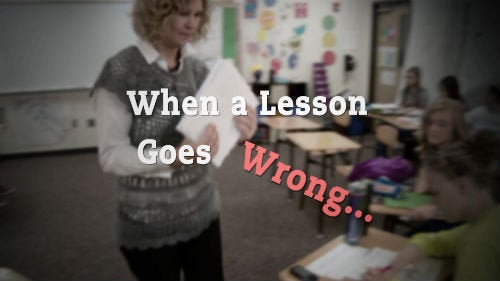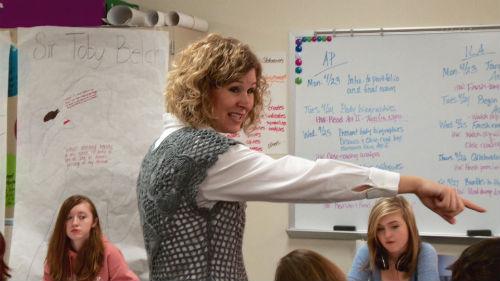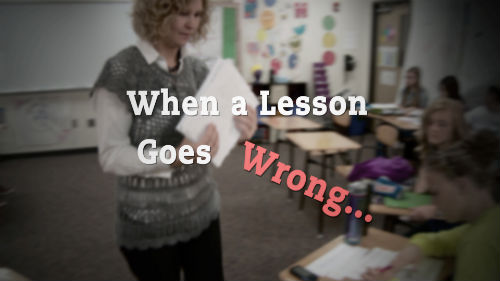
I have a unique teaching lens. Literally -- in the form of cameras in my classroom. Several times a year, Teaching Channel comes into my classroom to shoot video of me with my students as we teach and learn together. Without fail, the camera lens reflects what's too often impossible to notice while I'm trying to be fully present with my students. It was for this reason -- the desire to keep getting better -- that I joined Teaching Channel as their Teacher Laureate.
By now my students and I are comfortable with the cameras, sometimes forgetting they are there. But, my comfort level changed dramatically when my third hour sophomore English class was a total bomb. A disaster. I started with over 15 minutes of me talking at the students (unusual for me), then I gave them several articles to read that were too long and too complicated without enough background knowledge to give them confidence. They were unengaged, unmotivated and uninterested in anything related to the lesson. When I enthusiastically said it was time to get to work, they briefly looked at me and then just started socializing with each other. Yes, it was one of those moments where the whole thing had gotten away from me.

And there I was with the unflinching lens catching it all. At first I was mortified, thinking why did the camera have to be here today? Why not yesterday or tomorrow or any other day? But then I remembered exactly why I had wanted the cameras in the first place.
I wanted the cameras because I was ready to be vulnerable for other teachers. I was ready to share the successes and the struggles, believing that if I would share, others would too and that would be a step towards building the kind of community around this profession that would engage us all in the productive work of continuous growth.
So the cameras caught the bottom falling out, but they also caught the five-minute rally in-between classes and next class period where I was literally figuring it out, in a much better way, as I was teaching. And within about 48 hours of its posting on Teaching Channel, this 16-minute piece became the most popular video in the library.
In ways that other Teaching Channel videos of mine highlight a strategy, this one demonstrated a process: how to salvage a lesson gone wrong. By thinking out loud to the cameras I identified what had gone wrong in third hour. Then, I used the five-minute passing period to revise the lesson for fourth hour.
Immediately I started to consider my mistakes: 1) I stood in front of the class for too long, talking at my students; 2) I gave directions that weren't clear enough (which meant the task wasn't as clear in my mind as I thought it was); 3) the students hadn't been aptly prepared to read these texts on their own.

Then, I needed to get centered on my purpose: the students needed to learn how to connect a conceptual understanding from these pieces of informational text in a way that would help them see more nuances in The Crucible. Finally, I had to create a new path towards the learning purpose, which had to be a total improvisation that would only be successful if I pushed away my own anxiety and focus on the clues my students always give me, when I pay attention.
This video was also the first of its kind -- a clear disaster, a teacher thinking out loud about how to contend with it and the recovery with reflection. The discussion board lit up, the blog got busy and I spent the better part of a weekend fielding comments on my social networks. I was surprised and humbled by what I heard: "You're so brave," "This is inspirational," "What courage to show what happens to all of us" or "This is the art of teaching." As I noticed patterns in the feedback, I started to piece together what made this video so compelling: it exposed what we try so hard not to talk about in teaching.
It was like a collective exhale for all educators who give unbridled passion to this work and who know that despite the most perfect plan on paper, you can never account for the unexpected. It was a nod of pardon for all of those imperfect days that we have become conditioned to sweep into the shadows of our pedagogy. And perhaps, it was about a little forgiveness that we never give ourselves because there's always another standard to meet, an evaluation to account for, a strategy to be implemented or a child to be saved. Yet, it's what we need most.
We need permission to be imperfect, which is not to say we need permission to become stagnant or unenthused or fixed. But living in places that squelch mistakes only grows mediocrity. If we don't want education to be dressed in a culture of defensiveness and excuses, then we must take them away by welcoming such classroom foibles as authentic opportunities to flourish, not as shortcomings to bemoan.
